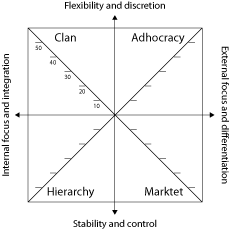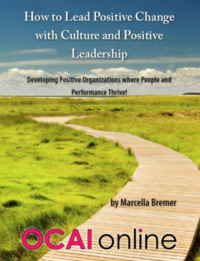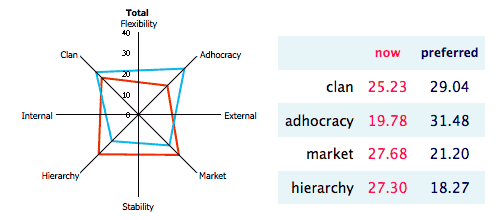The Organizational Culture Assessment Instrument (OCAI) developed by Cameron and Quinn is a method to assess organizational culture.
Substantial research was involved in developing the OCAI. Professors Cameron and Quinn developed the model of the Competing Values Framework which consists of four Competing Values that correspond with four types of organizational culture.
Every organization has its own combination of these four types of organizational cultures.
This mix is found by the completion of a short survey. This assessment is a valid approach to looking at organizational culture and the wish for change. The OCAI is currently used by over 12,000 companies worldwide.
OCAI questionnaire
The test taker must split 100 points over a total of four descriptions that matches the four culture types, according to the present organization. This method determines the blend of the four culture types that dominate the current organizational or team culture.
By answering the questionnaire a second time, this time dividing 100 points according to what the respondent would like to see in the organization, the preferred organizational culture and the desire for change can be calculated.
Test takers assess six key characteristics of their corporate culture:
- dominant characteristics
- organizational leadership
- management of employees
- organization glue
- strategic emphases
- criteria of success
By averaging all individual OCAI scores, you can work out a combined organization profile. In smaller teams, it’s also possible to use all the distinct individual profiles and talk about them.
A culture profile illustrates the following:
- The dominant culture
- The strength of the dominant culture (the amount of points given)
- Discrepancy between present and preferred culture
- The congruency of the six features. Cultural incongruence frequently leads to a desire to change, because different values and goals can take a lot of time and debate
- Evaluation of the culture profile with the average for the sector
- Comparison with average tendencies; in what phase of development is the organization?
The outcome
From Quinn and Cameron’s extensive study, it was found that most organizations have developed a leading culture style. An organization rarely has only one culture type. Time and again, there is a mix of the four organizational cultures.
The Competing Values Framework states that the values and the corresponding organizational cultures compete with each other. Organizations can spend their money, attention, and time only once, so they tend to emphasize particular values.
Quinn and Cameron found that flexible organizations are the most successful, which sometimes leads to conflicting behavior. The “best” organizations can address the competition within this framework well and use all four value sets when needed.
A culture type performs best in the activities domain that aligns with that specific culture type. In the healthcare sector, for example, we discovered a lot of clan culture. This type genuinely fits in with the profession of looking after people. There is no final “best” organizational culture. Only in a particular circumstance will one class of culture serve better than another.
The Competing Values Framework
From a list of thirty-nine indicators of effectiveness for organizations, two vital dimensions were discovered by statistical analysis.
Cameron and Quinn made four quadrants corresponding with the four organizational cultures that differ deeply on these two dimensions:
- Internal focus and integration vs. External focus and differentiation
- Stability and control vs. Flexibility and discretion
 To the left in the graph, the organization is internally centered (what is important for us, and how do we want to work?), and to the right, the organization is externally focused (what is valuable for the outside world, the clients, and the market?).
To the left in the graph, the organization is internally centered (what is important for us, and how do we want to work?), and to the right, the organization is externally focused (what is valuable for the outside world, the clients, and the market?).
At the top of the graph, the organization desires flexibility and discretion, while at the bottom the organization values the opposite: stability and control.
The Four Culture Types
The Clan Culture
This working environment is a sociable one. People have a lot in common, and it’s like one big family. The executives are seen as mentors or maybe even as father figures. The organization is held together by commitment and tradition. There is great involvement. The organization emphasizes durable Human Resource development and connects fellow workers by morals. Success is identified within the framework of addressing the needs of the clients and caring for the people. The organization encourages teamwork, participation, and consensus.
Leader Type: facilitator, mentor, team builder
Value Drivers: Commitment, communication, development
Theory of Effectiveness: Human Resource development and involvement are effective
Quality Improvement Strategy: Empowerment, team building, employee participation, Human Resource development, open communication
The Adhocracy Culture
This is an energetic and creative working environment. Employees take risks. Leaders are innovators and risk takers. Experiments and innovation are the bonding materials within the organization. Prominence is emphasized. The long-term goal is to grow and create new resources. The availability of new products or services is seen as an achievement. The organization encourages individual ingenuity and freedom.
Leader Type: Innovator, entrepreneur, visionary
Value Drivers: Innovative outputs, change, agility
Theory of Effectiveness: Innovativeness, vision, and new resources are effective
Management Theory: Surprise and delight, creating new standards, anticipating needs, continuous improvement, finding creative solutions
The Market Culture
This is a results-based organization that highlights completing work and getting things done. People are competitive and concentrated on goals. Leaders are hard drivers, producers, and competitors at the same time. They are tough and have high expectations. The importance of winning keeps the organization together. Reputation and success are the most important. Long-term focus is on rival activities and reaching goals. Market penetration and stock are the definitions of success. Competitive prices and market leadership are key. The organizational style is based on competition.
Leader Type: Hard driver, rival, producer
Value Drivers: Market share, goal achievement, profitability
Theory of Effectiveness: Aggressively competing and customer focus are effective
Quality Improvement Strategy: Measuring client preferences, improving productivity, creating external partnerships, improving competitiveness, getting customers and suppliers to participate
The Hierarchy Culture
This is a formalized and structured work environment. Procedures decide what people do. Leaders are proud of their efficiency-based coordination. Keeping the organization functioning effortlessly is most crucial. Formal rules and policy keep the organization together. The lasting goals are stability and results, paired with the efficient and smooth execution of tasks. Trustful delivery, smooth planning, and low costs are the characterization of success. The personnel management has to guarantee work and values predictability.
Leader Type: Coordinator, monitor, organizer
Value Drivers: Efficiency, timeliness, consistency, and uniformity
Theory of Effectiveness: Control and efficiency with capable processes are effective
Quality Improvement Strategy: Error detection, measurement, process control, systematic problem solving, quality tools
Why do organizations and teams make use of the OCAI?
The OCAI online culture assessment will supply you with the following:
- Insight into the dominant culture of your organization
- Insight into how market focused, hierarchic, personal and/or innovative your organization performs
- A measure of satisfaction by assessing the discrepancy between current and preferred culture
- A quick and straightforward point of comparison before and after restructuring, change, or merger
- A clear feeling of the preferred culture as a preliminary point for a strategy of change
- An awareness of culture as an important factor in success
- An objective and validated measure of how culture is recognized, which is a starting point for change
Research shows that organizational culture is “the difference that makes the difference”—it is the reason why 70 percent of all mergers and reorganizations fail. The powerful cultural factor is really not as “undefined” as prejudice would have it. Culture is ordinarily experienced as obvious: people are not noticing. That’s why a description of it is not so straightforward while changing culture is even harder.
The power of the OCAI assessment is in the classification of your culture so that you can begin to see and explain it. It is the first step. OCAI offers you some grip to actually start changing; what course are we taking? With the OCAI Work Kit that OCAI Online offers you, you also have a step-by-step manual to fully make use of this system.
Use the OCAI method with its clear benefits for analyzing and changing the culture:
- It is valid: not only do people recognize their outcomes, but the OCAI is also validated and has a verified basis.
- It’s quantitative: providing a measurement from the test, completed by qualitative information during the process of discussing and working with the results to determine the desired changes.
- It’s involving: either by including all personnel or those who give direction and conduct change.
- It’s focused: it measures the six key dimensions that make a difference in success.
- It’s timely: both assessing and developing a change strategy can be accomplished in a sensible period.
- It’s manageable: it can be undertaken and implemented by a (management) team; no outside experts or consultants are required.
If you want to learn how to work with culture and the OCAI culture assessment to help your organization change successfully, check out the eBook “How to guide Positive Change with Culture and Positive Leadership”.
For more blog posts and applications of the OCAI, please check the official OCAI Blog.
By the way, I also have an OCAI video training for those who prefer watching above reading. You can enroll today 🙂
Copyright Marcella Bremer. All rights reserved.
 Are you engaged at work? Are you content, productive and contributing your best? Are you thriving? Most people would answer these questions with a firm No. According to the infamous Gallup research, only 13% of workers is engaged, worldwide. This means there is a staggering 87% of untapped potential while the world is struggling with serious challenges such as the climate, sustainability, pollution, poverty, human rights, inequality, globalization, de-industrialization, refugees and migration, banking crises, tax havens, war, and conflict…
Are you engaged at work? Are you content, productive and contributing your best? Are you thriving? Most people would answer these questions with a firm No. According to the infamous Gallup research, only 13% of workers is engaged, worldwide. This means there is a staggering 87% of untapped potential while the world is struggling with serious challenges such as the climate, sustainability, pollution, poverty, human rights, inequality, globalization, de-industrialization, refugees and migration, banking crises, tax havens, war, and conflict…

 To the left in the graph, the organization is internally centered (what is important for us, and how do we want to work?), and to the right, the organization is externally focused (what is valuable for the outside world, the clients, and the market?).
To the left in the graph, the organization is internally centered (what is important for us, and how do we want to work?), and to the right, the organization is externally focused (what is valuable for the outside world, the clients, and the market?).